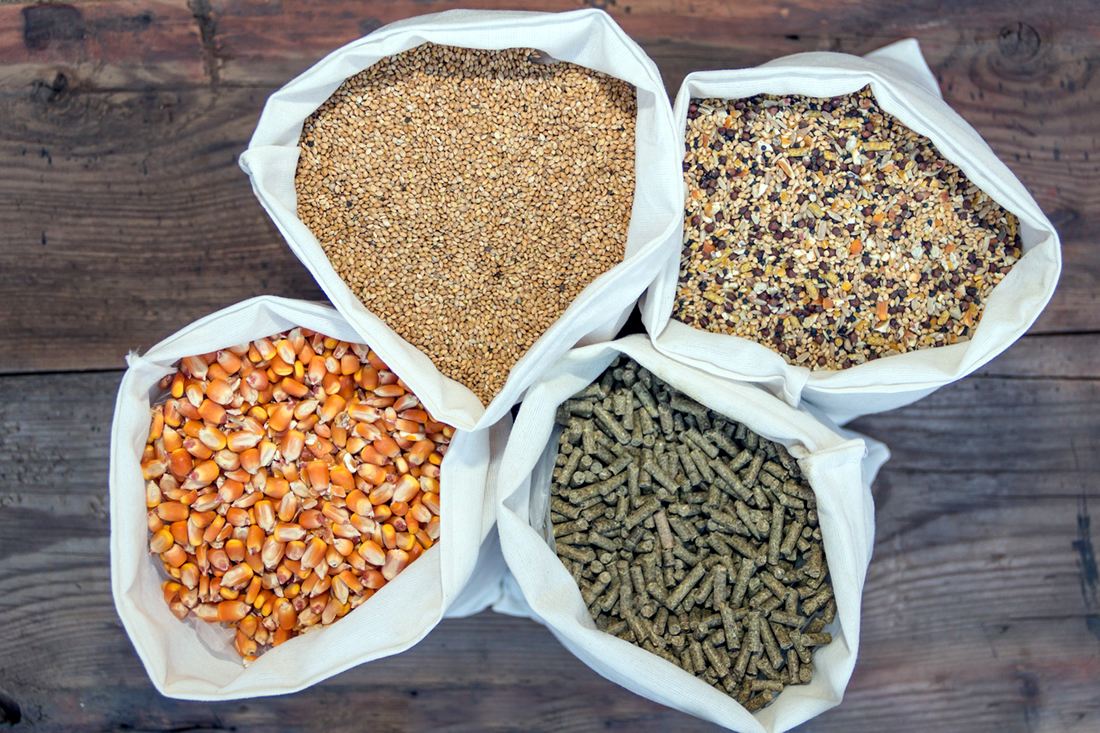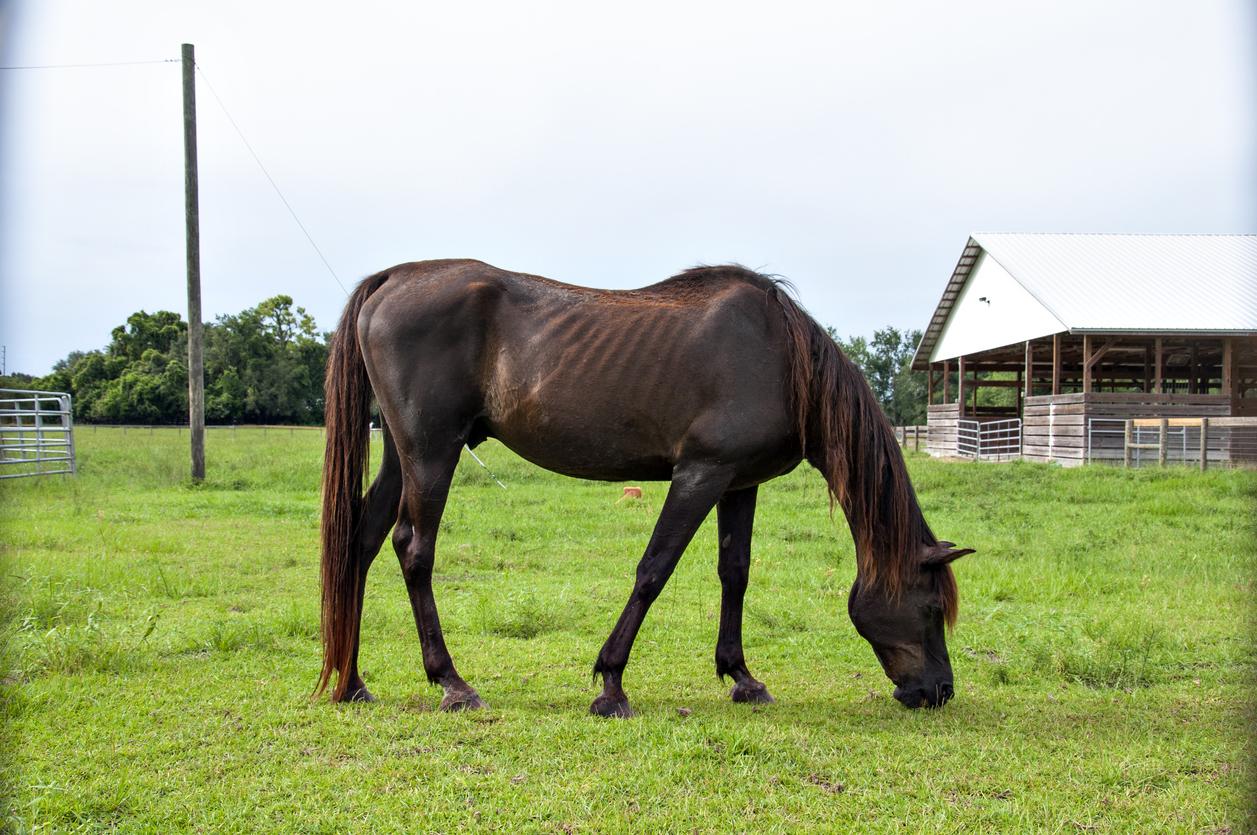Carbohydrates are the main energy source in an equine diet. These macronutrients are naturally abundant in forages, grains and grain by-products.
Carbohydrates can be categorized based on their function in the plant and how they are digested by the horse.
Simple sugars and carbohydrates found within plant cells are digested in the foregut. Structural carbohydrates found in the cell wall of the plant are fermented by microbes in the hindgut.
The horse’s digestive tract is better suited for diets high in structural carbohydrates. These are indicated on a guaranteed analysis or forage report as neutral detergent fibre (NDF), acid detergent fibre (ADF) or crude fibre.
Diets high in starch and sugars are not typically recommended for horses because they can contribute to health issues such as insulin resistance, obesity, laminitis and hindgut acidosis.
Sugars are listed in a feed analysis as water-soluble carbohydrates (WSC) or ethanol-soluble carbohydrates (ESC). The calculated values of non-fibre carbohydrates (NFC) and non-structural carbohydrates (NSC) are also used to indicate carbohydrate levels.
This article will discuss carbohydrate sources in the equine diet, how they are digested and metabolized to impact equine health and how they are defined on a guaranteed analysis or forage analysis.
Carbohydrates in the Equine Diet
According to the Nutrient Requirements of Horses (2007), carbohydrates can be divided into three categories that reflect how they are broken down in the horse’s digestive tract. [1]
1) Hydrolyzable Carbohydrates
These are carbohydrates that are digested in the small intestine – the first section of the intestine after the stomach. Enzymes produced by cells of the intestine or from the pancreas break down these molecules to allow their absorption.
Simple sugars and starch are the most abundant forms of hydrolyzable carbohydrates in the equine diet. These are higher in grains than forages.
Starch is a long chain of hundreds or thousands of glucose molecules. Starch can exist as amylose (a linear chain of glucose molecules) or amylopectin (a branched structure).
Simple sugars (monosaccharides) and compounds of 2 sugars bound together (disaccharides) include:
- Glucose: A monosaccharide that triggers insulin secretion and is a primary energy source for most cells of the body
- Fructose: A monosaccharide that can be used for energy in the body or converted into fat
- Sucrose: A disaccharide of glucose and fructose
- Maltose: A disaccharide of two glucose molecules; this is a product of starch digestion in the small intestine
- Lactose: A disaccharide of glucose and galactose. this is the main sugar found in milk and is an important energy source for foals
Monosaccharides and disaccharides are low in forage-based diets. However, they can be linked together to form longer chains, such as starch and oligosaccharides.
Oligosaccharides consist of short chains of 3 – 10 sugars. Some examples of oligosaccharides in feed include fructooligosaccharides, raffinose and stachyose.
Depending on the type of bond between subsequent sugar molecules, the enzymes of the small intestine may or may not be able to break these into shorter chains or monosaccharides.
2) Rapidly Fermentable Carbohydrates
Besides starch, most complex carbohydrates cannot be broken down by the enzymes in the small intestine of the horse.
This is because the enzymes the horse produces can only digest alpha linkages, such as those found in starch. They cannot break the beta linkages found in other complex carbohydrates.
Instead, complex carbohydrates are broken down (fermented) by microbes in the hindgut.
Depending on their structure, some complex carbohydrates are rapidly fermented by microbes, including:
- Resistant starch: includes starch that escapes digestion in the small intestine due to starch overload or because it is not accessible to animal enzymes
- Oligosaccharides: short chains that are not digested in the small intestine
- Pectins, gums and mucilages: soluble fibre found in the cell wall of fruits, sugar beets, grasses and legumes
- Fructans: short chains of fructose that act as an energy storage form in plants, especially cool-season grasses
These complex carbohydrates are easily fermented by the microbes of the hindgut. This process produces volatile fatty acids (VFAs, also known as short-chain fatty acids) and lactic acid. The VFAs are absorbed and used for energy by the horse.
Excess lactic acid production in the hindgut can be detrimental. For example, excess starch reaching the hindgut rapidly increases lactic acid, which reduces pH (making the environment more acidic).
This disrupts the microbial populations and can lead to health issues, including hindgut acidosis, colic, and laminitis. [2][3]
3) Slowly Fermentable Carbohydrates
Structural carbohydrates that give plants their rigid structure are commonly referred to as fibre. These have a more complex structure and require more time for microbial fermentation.
The most abundant slowly fermentable carbohydrates in forages are: [1][4]
- Cellulose: a non-branched structure of glucose molecules organized into a microfibril structure
- Hemicellulose: a branched structure of various sugars
Fermentation of cellulose and hemicellulose produces volatile fatty acids, which are beneficial to other microbes in the hindgut and the horse. VFAs provide 30% to 70% of the horse’s energy needs. [5][6]
The three VFAs produced by hindgut fermentation are: [7]
- Acetate: a two-carbon structure that is metabolized in the liver to make fat to store energy in the body
- Propionate: a three-carbon structure that is metabolized in the liver to make glucose as an energy source for the body
- Butyrate: a four-carbon structure that is mostly used as an energy source by cells of the gastrointestinal tract

Nutrition: Carbohydrate Fractions
Feed or forage analysis is the only way to estimate how much of each carbohydrate your horse gets in their diet.
Laboratory methods to conduct these analyses are traditional wet chemistry or near-infrared spectroscopy. Wet chemistry is more expensive and time-consuming but is generally considered more accurate. [8]
The names given to carbohydrate fractions are based on wet chemistry procedures established by Van Soest in the 1960s and are still widely used today. [9] These fractions can be used to estimate the amount of hydrolyzable, rapidly fermented, and slowly fermented carbohydrates in the diet.
Below are descriptions of the main carbohydrate fractions reported on forage and feed analyses.
Neutral-Detergent Fibre (NDF)
What remains after the sample is dissolved in neutral detergent and filtered is called the neutral detergent fibre (NDF). The major components of NDF are:
- Hemicellulose
- Cellulose
- Lignin
Lignin is a structural carbohydrate that is neither digestible by animal enzymes in the small intestine nor by microbes in the hindgut. Some laboratories and feed tags also report the lignin content as a separate value.
NDF can be used to estimate forage intake in horses. As NDF content increases, voluntary intake tends to decrease, meaning horses given unrestricted access will consume less of the forage. [10]
Acid-Detergent Fibre (ADF)
The NDF fraction is further digested by acid detergent, which removes hemicellulose. The major components of ADF are:
- Cellulose
- Lignin
These represent the least digestible components of forage. The higher the ADF content, the lower the forage’s digestible energy (DE) or calorie content. [1]
Mathematically, the DE content of forage is calculated from the percent of ADF (%ADF) and crude protein (%CP) by the equation: [1]
Crude Fibre (CF)
Crude fibre indicates the plant carbohydrates that are not digestible by the horse, but may be fermented in the hindgut.
ADF and crude fibre represent similar fractions of plant carbohydrates but are obtained through different lab procedures. ADF tends to be higher than CF because it captures more cellulose.
A feed with low CF is likely energy-dense and more suitable for high-performance horses or lactating mares.
Non-Structural Carbohydrates (NSC)
NSC represents the cell contents which contain hydrolyzable carbohydrates and rapidly fermentable carbohydrates.
Water-soluble carbohydrates (WSC)
The water-soluble carbohydrates (WSC) fraction consists of hydrolyzable carbohydrates that are soluble in cold water or gastrointestinal fluid, including:
- Monosaccharides (ex: glucose, fructose)
- Disaccharides (ex: sucrose)
- Oligosaccharides
- Fructans
Ethanol-soluble carbohydrates (ESC)
ESC is a sub-fraction of WSC.
The water-soluble fraction is treated with 80% ethanol to extract simple sugars and disaccharides. Therefore, ethanol-soluble carbohydrates consist primarily of:
- Glucose
- Fructose
- Sucrose
Starch
Starch remains after ethanol extraction of soluble sugars. The starch is digested in vitro by the enzyme alpha-amylase to produce glucose.
The glucose concentration is then converted to a starch concentration value. [9]
NSC Value
The %NSC on a feed tag or forage analysis is a calculated value. Based on the NRC (2007), NSC is calculated as WSC plus starch. [1]
Intake of feeds and forages with a high HC component in the NSC can result in higher blood glucose and insulin levels and lead to insulin resistance. [11]
This is largely attributed to the glucose component of ESC and starch fractions. Therefore, to estimate the impact of a feed or forage on metabolic health, a more appropriate calculation of NSC is ESC plus starch.
Mad Barn’s Feed Bank presents NSC as the sum of ESC and starch.
Non-Fibre Carbohydrate (NFC)
NFC is a calculated value intended to represent the carbohydrates that are not within the cell wall matrix and not captured in the NDF fraction.
NFC represents starch, sugars and rapidly fermentable carbohydrates. The NFC calculation is:
Soluble Fibre
Similar to NFC, soluble fibre is a calculated value that represents hydrolyzable and rapidly fermented carbohydrates, such as pectins, gums and mucilages. Unlike NFC, this value excludes starch and sugars.
Soluble fibre is calculated as follows:
Feeds that are high in soluble fibre include citrus and beet pulp.
Choosing Carbohydrate Sources for Your Horse
Forage should be the main component of any horse’s diet. Horses evolved to forage up to 18 hours per day, leaving little time for their stomach to be empty.
The horse is also a hindgut fermenter that relies on microbial fermentation to get energy from relatively low-quality pasture grasses and vegetation.
In modern management systems, providing regular turnout and offering free-choice hay is ideal for maintaining gut health.
Selecting a forage that allows free-choice feeding without significantly over- or under-supplying digestible energy is important.
High-quality forage that is low in ADF (cellulose and lignin) and high in protein will supply higher quantities of easily digestible carbohydrates. This may be appropriate for horses with high energy needs such as endurance horses, lactating mares and growing foals.
Easy keepers and horses at maintenance will likely become overweight if given free-choice access to high-quality forage.
For horses with lower energy needs, a mature forage with higher levels of structural carbohydrates (NDF & ADF) would be more appropriate. Straw can also be used to dilute high-quality hay for these horses.
Additional Carbohydrate Sources
If additional energy sources are required in addition to forage, consider other sources of fermentable carbohydrates. Feeds with high soluble fibre values such as beet pulp, supply carbohydrates rapidly fermented in the hindgut, providing energy while supporting hindgut health.
Grains such as oats, corn, wheat, and barley can be added sparingly to equine diets. Grains provide high levels of digestible carbohydrates (starch and sugars).
Horses are not adapted to a high dietary intake of these carbohydrates. They can develop gastric ulcers and hindgut dysfunction with high grain intake.
When feeding starch, limit the amount to 2 g of starch per kg bodyweight per meal. For a 500 kg (1100 lb) horse, this equals 1 kg (2.2 lb) of starch per meal. [12][13]
For example, whole oats contain 40% starch on a dry matter basis. Roughly 2.7 kg of whole oats (as-fed basis) will provide 1 kg of starch daily. This should be divided into at least two meals per day to provide no more than 1 gram of starch per kg bodyweight in a single meal.
Horses with metabolic syndrome or hyperinsulinemia in PPID should have all HC (ESC + starch) in the total diet limited to 10%. When weight gain is needed, use free choice low HC hay and/or beet pulp or soy hulls.
Alternatively, you could consider using fat and oils, which are energy-dense and easily digested in the small intestine. Horses can be adapted to have up to 20% of their digestible energy needs met by fat.
Consult with an equine nutritionist to develop an optimal feeding plan for your horse based on their individual needs.
References
- National Research Council Nutrient Requirements of Horses: Sixth Revised Edition. 2007.
- Richards, N. et al. The effect of current grain feeding practices on hindgut starch fermentation and acidosis in the Australian racing Thoroughbred. Aus Vet J. 2006.
- Al Jassim, R.A.M. et al. The Bacterial Community of the Horse Gastrointestinal Tract and Its Relation to Fermentative Acidosis, Laminitis, Colic, and Stomach Ulcers. Vet Clinics: Equine Pract. 2009.
- Rongpipi, S. et al. Progress and Opportunities in the Characterization of Cellulose – An Important Regulator of Cell Wall Growth and Mechanics. Front Plant Sci. 2019.
- Glinsky, M.J. et al. Measurement of volatile fatty acid production rates in the cecum of the pony. J Anim Sci. 1976.
- Vermorel, M. et al. Energy utilization of twelve forages or mixed diets for maintenance by sport horses. Livest Prod Sci. 1997.
- Bergman, E.N. Energy contributions of volatile fatty acids from the gastrointestinal tract in various species. Physiol Rev. 1990.
- Harris, P.A. et al. Comparison of NIRS and Wet Chemistry Methods for the Nutritional Analysis of Haylages for Horses. J Equine Vet Sci. 2018.
- Official Methods of Analysis of AOAC INTERNATIONALTM (OMA). 2019.
- Meyer, K. et al. The relationship between forage cell wall content and voluntary food intake in mammalian herbivores. Mammal Rev. 2010.
- Siciliano, P.D. et al. Effect of Sward Height on Pasture Nonstructural Carbohydrate Concentrations and Blood Glucose/Insulin Profiles in Grazing Horses. J Equine Vet Sci. 2017.
- Durham, A.E. The role of nutrition in colic. Vet Clin NA Equine Pract. 2009
- Julliand, V. Starch digestion in horses: the impact of feed processing. Livest Sci. 2006.












Leave A Comment